Sustainability Management
In 2020, ASPEED Technology established a CSR Working Team and converted it into the Sustainability Committee under the Board of Directors in 2021 as a key decision maker for ASPEED’s sustainable development, and was officially restructured into a formal functional committee in November 2024. Under the committee will be the Sustainability Development Working Team, which, in addition to regularly overseeing the performance of corporate sustainability-related activities, is even responsible for incorporating sustainable development into the decision-making process for corporate operations and important strategies, leading the five work teams of “Corporate Governance”, “Risk Management”, “Environmental Sustainability”, “Employee Relations” and “Social Participation” to coordinate the implementation of each aspect. The Sustainability Development Working Team under ASPEED Technology’s Sustainability Committee is responsible for gathering the concerns from various stakeholders and keeping abreast of the development trends of domestic and foreign laws and policies. A meeting is held biannually for each work team to report on their operation. We conduct regular review on ASPEED’s sustainability strategies and short-to-medium term plans to make adjustments as needed. A meeting was held in each of the first and second half of 2024, covering:
- Report on the progress of the Sustainability Development Working Team
- Science-based target setting
- Renewable energy purchase plan submission for approval
- Implementation of Whistleblower Reporting System
- GHG inventories and related operations
- Report on the 2023 Sustainability Report and ESG Summary for approval and provide an explanation of the strategy for promoting and implementing sustainable development management in 2024.
Sustainability Blueprint
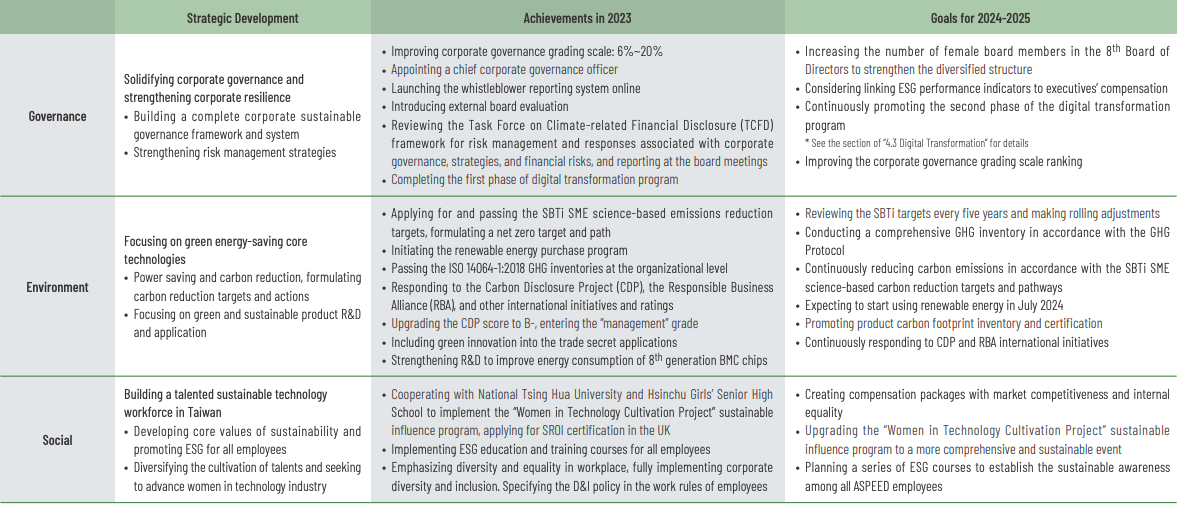
Risk Management
Risk Management Policies
ASPEED Technology is a fabless IC design company. Having adopted a “Fabless Lite 2.0” operating model, our workforce primarily consists of R&D personnel, management and marketing staff, and administrators. We do not routinely engage in foundry production processes. Changes to the global economic environment and the potential internal and external operational impacts of sustainability risks underscore the importance of preventing problems before they emerge. Knowing how to avoid problems and respond to risk is critical. ASPEED Technology therefore formulated the Risk Management Policy, which uses corporate governance, environmental, and social topics as a foundation to identify risks that could have an impact on the Company’s sustainable development. The Company then crafts follow-up response strategies that are in line with primary areas of concern for our stakeholders as well as international trends.
Material Risk Management and Responses
To respond to unpredictable risks that emerge during business and to be on guard against the negative effects of internal and external environmental changes, ASPEED Technology established risk management units that are overseen by the Sustainability Committee, under the Board of Directors. After considering various business continuity standard requests and following internal evaluations, the risk management units implement control and management measures. The management framework primarily involves monitoring, analysis, and confirmation of risks by finance, business, administration, environment & safety, and information security units. They then report on these risks to management and launch response mechanisms. Investor relations, media relations, and public relations staff communicate these issues externally at the appropriate time to ease any concerns of stakeholders. By identifying risks, managing organizational and operational risks, and formulating countermeasures, related staff members play a critical role in risk control.

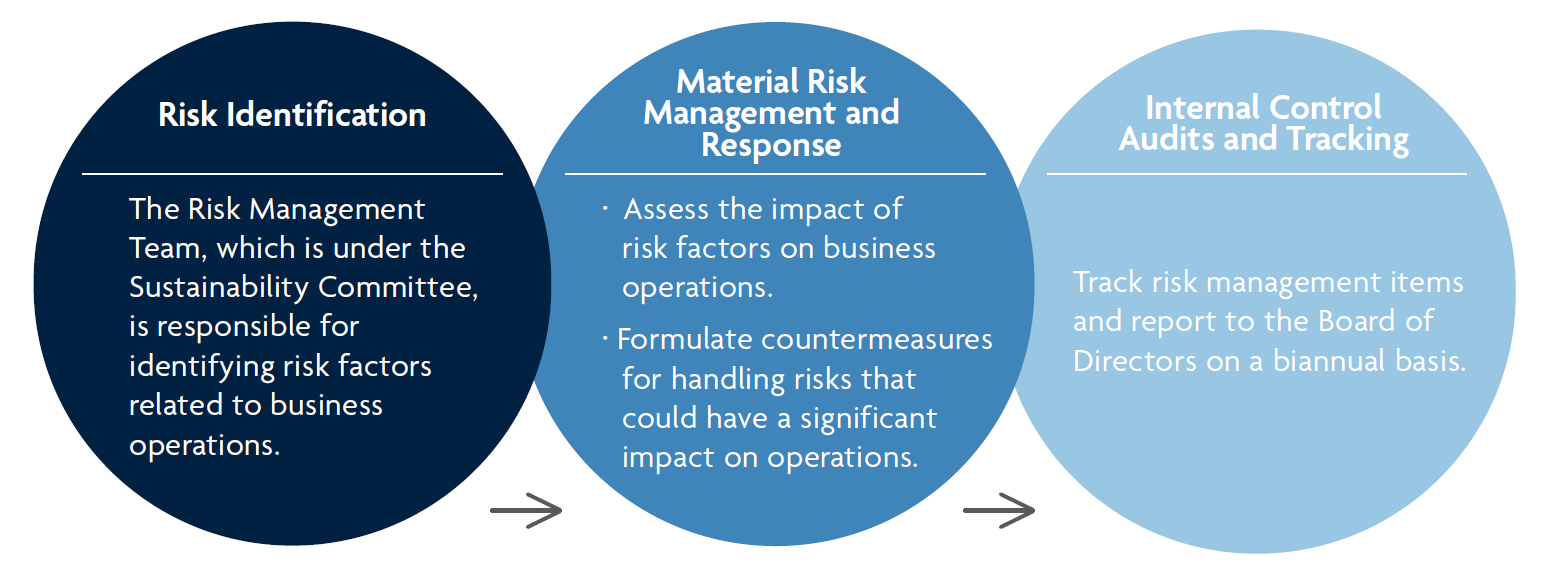
Risk Identification
ASPEED Technology carries out risk identification, analysis, evaluation, response, and tracking based on the Company’s internal organization and core business as well as external environmental conditions. Scope covers corporate governance, environmental, and social aspects, and other sustainable development areas. In 2024, seven material risk factors we identified were: “market risk”, “operation/technology”, “occupational safety”, “information security”, “public health”, “climate change risk” and “supply chain management”. In response to climate change risks, we have incorporated them into the risk identification procedures in 2024, and revealed four core elements: “governance”, “strategy”, “risk management” and “indicators and targets” based on the recommendations of TCFD to identify the material risks and opportunities that climate change may cause to ASPEED. At the same time, the risk team regularly considers domestic and international climate change topics, trends, and laws, as well as carbon emissions, and continues to manage and respond to the risks and opportunities posed by climate change shocks.
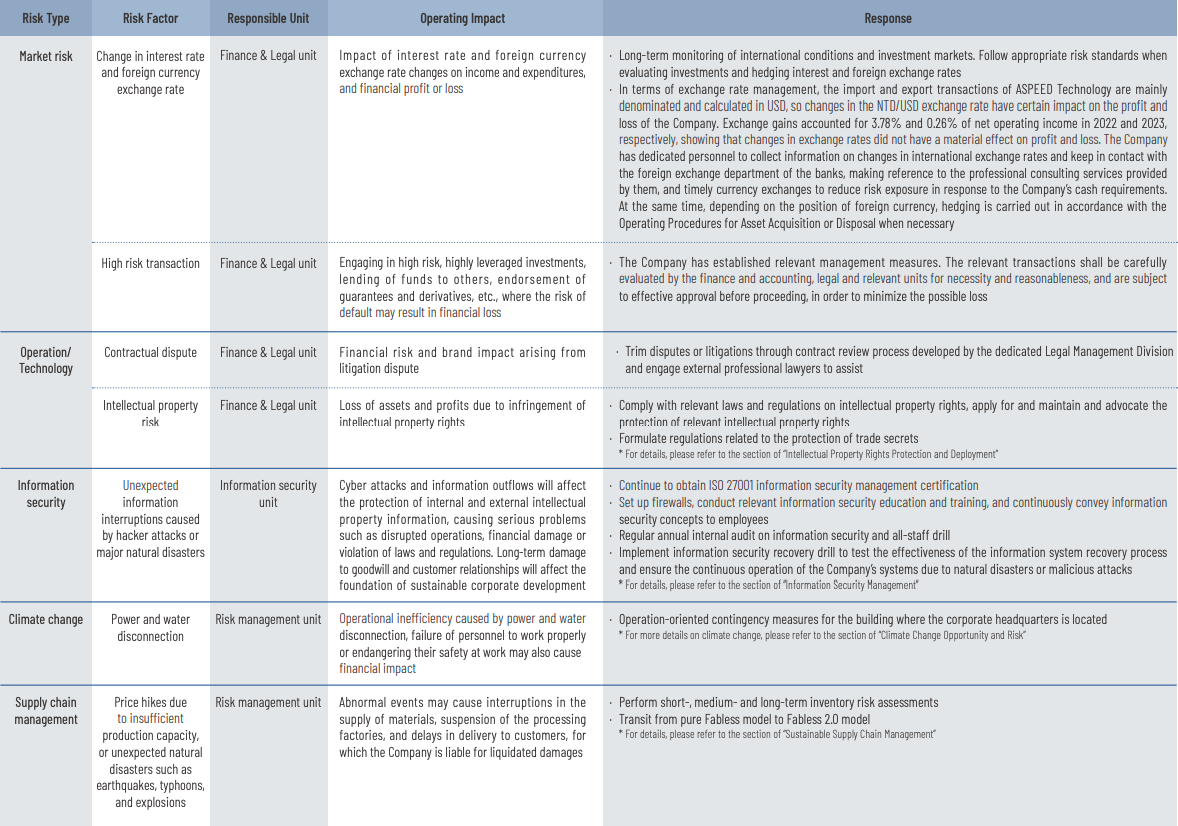
Climate change risk and opportunity management
Global warming and extreme climate have caused significant operational impact on enterprises. The challenges of climate change faced by enterprises are currently one of the most urgent issues. Since 2022, ASPEED Technology has voluntarily adopted the proposed guidance on Task Force on Climate-related Financial Disclosures (TCFD), and revealed four core elements: “governance”, “strategy”, “risk management” and “indicators and targets” in accordance with the recommendations of TCFD to identify the material risks and opportunities that climate change may cause to ASPEED Technology, and put forward relevant response strategies. In April 2023, the Company officially signed as the “Task Force on Climate-related Financial Disclosures (TCFD)” Supporter. We pay close attention to the trend of global climate change and international development. At the same time, we also incorporate climate change issues into the key material issues of corporate sustainable development, and evaluate the impact and impact time within the Company. Meanwhile, based on the results of the analysis, we continue to control and respond to the risks and opportunities posed by the impact of climate change.
Identification process for climate change-related risks and opportunities
ASPEED Technology carries out matrix analysis on the potential impact of various climate change risks, including the direct or indirect physical impact of extreme climate, and the risks and opportunities of the impact of transformation with regulations, technologies or market demand. Based on the analysis results, we propose corresponding response measures, assess the financial impact of climate risks and opportunities, thereby adjusting the relevant internal management mechanism, and establishing an open and transparent communication channel with various stakeholders to reduce climate change risks and grasp the opportunities brought by climate change. ASPEED Technology identifies the risks and opportunities brought by climate change based on two or more climate change scenarios. Through climate change risk and opportunities workshops, we engage divisional heads and key members groups to conduct climate change research, discussion, information compilation, and review of climate risks and opportunities.
The specific identification process for risks and opportunities related to climate change is shown as follows:
| A. Setting a climate change scenario | B. Assessing operational environmental impact | C. Identify climate risks and opportunities |
|---|---|---|
|
Setting two climate change scenarios: SSP5-8.5: Hit up to 6°C SSP1-2.6: Hit up to 2°C |
Evaluating the impacts and consequences of two climate change scenarios on the operational environment and stakeholders of ASPEED Technology | Building a climate risk and opportunity matrix to identify high risks and opportunities of climate change |
After the completion of the identification of climate risks and opportunities, we identified 3 high-risk factors and 3 high-opportunity factors in 2022 based on the “possibility of occurrence” and “degree of impact” of risks or opportunities. The risk matrix and opportunity matrix of ASPEED’s climate change in 2022 is as follows:
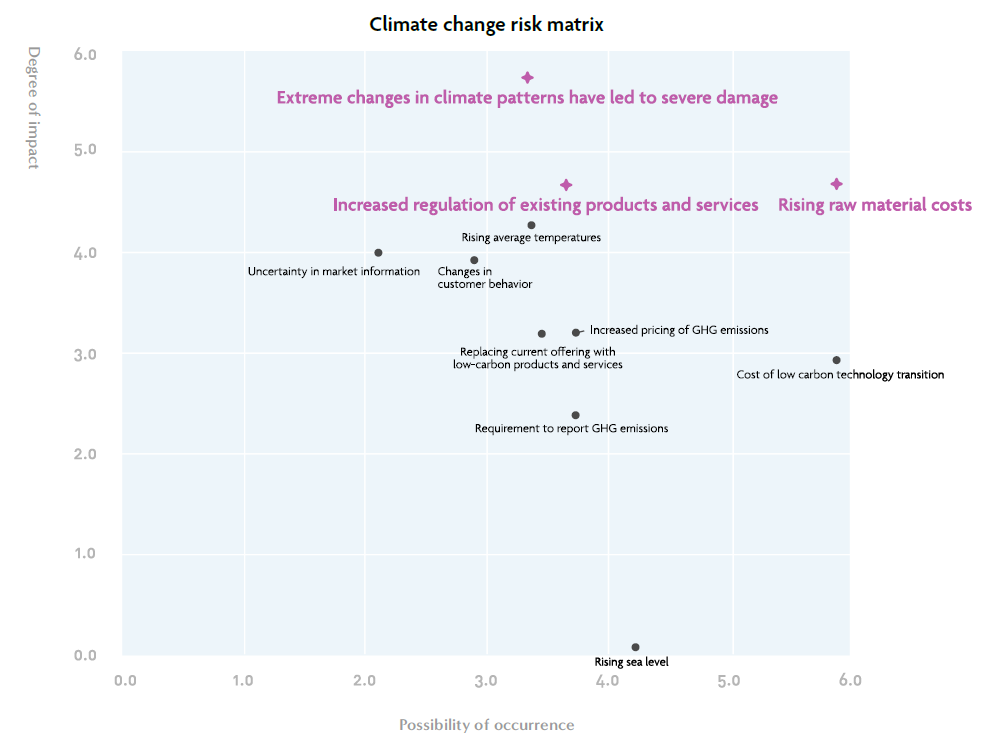

Description of risks associated with climate change
| Risk prioritization | Type of risks | Risk factor | Time of occurrence |
|---|---|---|---|
| 1 | Transition risks – market | Rising raw material costs | Short-term |
| 2 | Entity risks | Extreme changes in climate patterns have led to severe disasters | Medium-term |
| 3 | Transition risks – policies and regulations | Increased regulation of existing products and services | Medium-term |
Note: definition of time horizon: short term: 2022-2024, medium term: 2024-2030, long term: 2030-2050
Risk 001: Rising raw material costs
Impact scenario:
Due to climate change and global energy crisis, the difficulties in mining and production of silicon raw materials have increased, and the mining area may face the problem of power limitation and shortage of electricity. As a result, the cost of silicon raw materials increased greatly. Due to the increase in raw material costs and product costs, the Company’s competitiveness has been affected, resulting in a decrease in revenue.
| Risk impact oriented assessment |
|
| Financial impact oriented assessment | Increase in production costs |
Risk 002: Extreme changes in climate patterns have led to severe disasters
Impact scenario:
Due to the increasing severity of extreme weather, the adverse climate such as the increased intensity and duration of typhoons have caused flooding and power outages, affecting the operations of the Company and its foundries As a result of the severe weather:
- Decrease in production capacity, damage to equipment and difficulty in transportation of foundries led to reduction in supply or prolonged delivery
- Power outage caused damage to laboratory equipment, disrupted testing, and impacted product development progress; slower revenue on delayed output of the Company’s products
| Risk impact oriented assessment |
|
| Financial impact oriented assessment | Increase in operating costs, decrease in revenue |
Risk 003: Increased regulation of existing products and services
Due to the policies and regulations of various countries, customers require that the specifications of products need to be adjusted in the direction of low energy consumption, energy saving and power saving, and in line with green product regulations, so that the products can meet the regulatory specifications. Unusual changes in policies and regulations led to higher technical requirements for customer demand and higher uncertainty, resulting in higher costs for the Company; if the product design adjustment fails to meet the requirements of policies and regulations, it will have a negative impact on the internal and external stakeholders of the Company and affect the Company’s goodwill.
| Risk impact oriented assessment | Failure of meeting the requirements resulting in the revision of product specifications may affect the schedule of sales: the market demand for energy saving and carbon reduction is getting stronger, the power consumption standard of the end products is becoming more stringent in all countries, and the demand for products with low power consumption is increasing. If the products do not have enough competitiveness in terms of power consumption, the orders will be reduced and the time for product specification modification will be extended, affecting the revenue. |
| Financial impact oriented assessment | Decrease in revenue |
Response strategies for climate change-related risks
Response strategies to address rising raw material cost:
|
Response strategies to tackle severe disasters due to extreme changes in climate patterns:
|
Response strategies to strengthen the regulation of existing products and services:
|
Description of opportunities associated with climate change
| Opportunities prioritization | Type of opportunities | Opportunities factor | Time of occurrence assessment |
|---|---|---|---|
| 1 | Opportunities – products and services | Developing and increasing low-carbon goods and services | Medium-term |
| 2 | Opportunities – products and services | Changing consumer preferences | Short-term |
| 3 | Opportunities – resource efficiency | Adopting more efficient and effective ways of working | Medium-term |
Opportunity 001: Developing and increasing low-carbon goods and services
Impact scenario:
Following the global trend of decarbonization, the Company has expanded its low-carbon product range, such as high performance and low-energy low-carbon chips, development of cloud or AI-related application chips, and chips that can be used for smart energy saving. By developing low-carbon products, the Company will improve its market competitiveness, increase market share and raise revenue.
| Opportunities impact oriented assessment |
|
| Financial impact oriented assessment | Increase in revenue |
Opportunity 002: Changing consumer preferences
Impact scenario:
In response to the international trend of energy conservation and decarbonization, the demand for remote work and online services has increased significantly. The server industry has a clear growth trend, and the quality requirements of video equipment have also increased. The demand for server management chips and audio/video chips has been on the rise. Through changes in market trends and consumer preferences, the demand for the Company’s products will continue to increase, which will increase the Company’s revenue and enable the Company to continue to grow.
| Opportunities impact oriented assessment |
|
| Financial impact oriented assessment | Increase in revenue |
Financial impact oriented assessment
Impact scenario:
In response to the requirements of decarbonization, the Company will promote the digitization of its systems and processes and optimize the product development model. The systematic or cloud approach allows the Company to reduce carbon emissions, carbon expense and operating expenses.
| Opportunities impact oriented assessment |
|
| Financial impact oriented assessment | Cost reduction |
Financial impact oriented assessment
Execution strategies to develop and enhance low-carbon products and services:
|
Execution strategies in response to changing consumer preferences:
|
Execution strategies to adopting more efficient and effective ways of working:
|
Climate change-related indicators and targets
| Climate risks | Management targets | Management indicators |
|---|---|---|
| Extreme changes in climate patterns have led to severe disasters | Reduce the direct impact of climate disasters on work | Improve the implementation frequency of employees’ remote workflow |
| Improve the implementation frequency of workflow/cloud-based system | ||
| Improve the disaster response capacity of laboratories | Laboratory RTO established: Time target for disaster recovery | |
| Laboratory RPO established: Time target for systems & data recovery | ||
| Regularly implement laboratory emergency disaster protection education and training | ||
| Improve the disaster response capacity of foundries | Increase the proportion of foundries that develop operation continuity plans | |
| Increased regulation of existing products and services | Ensure that the Company is responsive to the latest legal and regulatory requirements | Regular updates on laws and regulations related to products |
| Regularly confirm whether the work process is updated in accordance with product-related regulations | ||
| Regularly confirm whether the requirements of suppliers are updated in accordance with product-related laws and regulations | ||
| Regular sharing of product-related laws and regulations |
Information Security
Information Security and Data Protection
As part of a commitment to managing information security, in addition to the introduction of Cortex XDR 2.0 in 2021 to prevent hack virus extortion, ASPEED Technology obtained ISO27001 information security certification in May 2022. With the “Information Security Policy” and 23 information security-related standards, these standards manage and protect the Company’s information security and reduce information security risks in our network, in order to protect personal information and customer privacy, and uphold the rights and interests of stakeholders. At the same time, the Company actively publicizes information security measures to raise awareness among employees.
For internal management, ASPEED Technology established a comprehensive internet and computing security network to maintain vital corporate functions, such as manufacturing operations, procurement and sales, and accounting. The Company periodically reviews and assesses cybersecurity architecture to ensure adequacy and effectiveness. Besides enhancing efficiency and backing up important information stored in our databases, in an evolving landscape of internet security threats, the Company must protect computer systems to prevent external network attacks that can cripple our systems. These measures prevent theft or hacking attacks on our trade secrets, intellectual property, and confidential information. For external suppliers and cooperative partners, ASPEED Technology achieves mutual assurance of information confidentiality by periodically confirming that suppliers have comprehensive information security management and backup plans in place. Furthermore, ASPEED Technology protects confidentiality by requiring 100% of employees to sign a nondisclosure agreement. For some projects and cases cooperative partners must also sign an NDA to guarantee that each parties’ information is protected.
In 2022, ASPEED Technology was not aware of any material information security incidents or cyberattacks, nor had it been involved in any legal proceedings or regulatory investigations related thereof. The audit and assurance firm Deloitte conducted an information operations audit on the Company in 2022 that covered the following areas: understanding the customer’s computer processing environment, general computer controls, and application system automated controls. It did not uncover any problems.

Information Security Policy and Goals
For business to proceed smoothly and to ensure confidentiality, integrity, and availability, ASPEED Technology formulated an information security policy that all employees must follow.
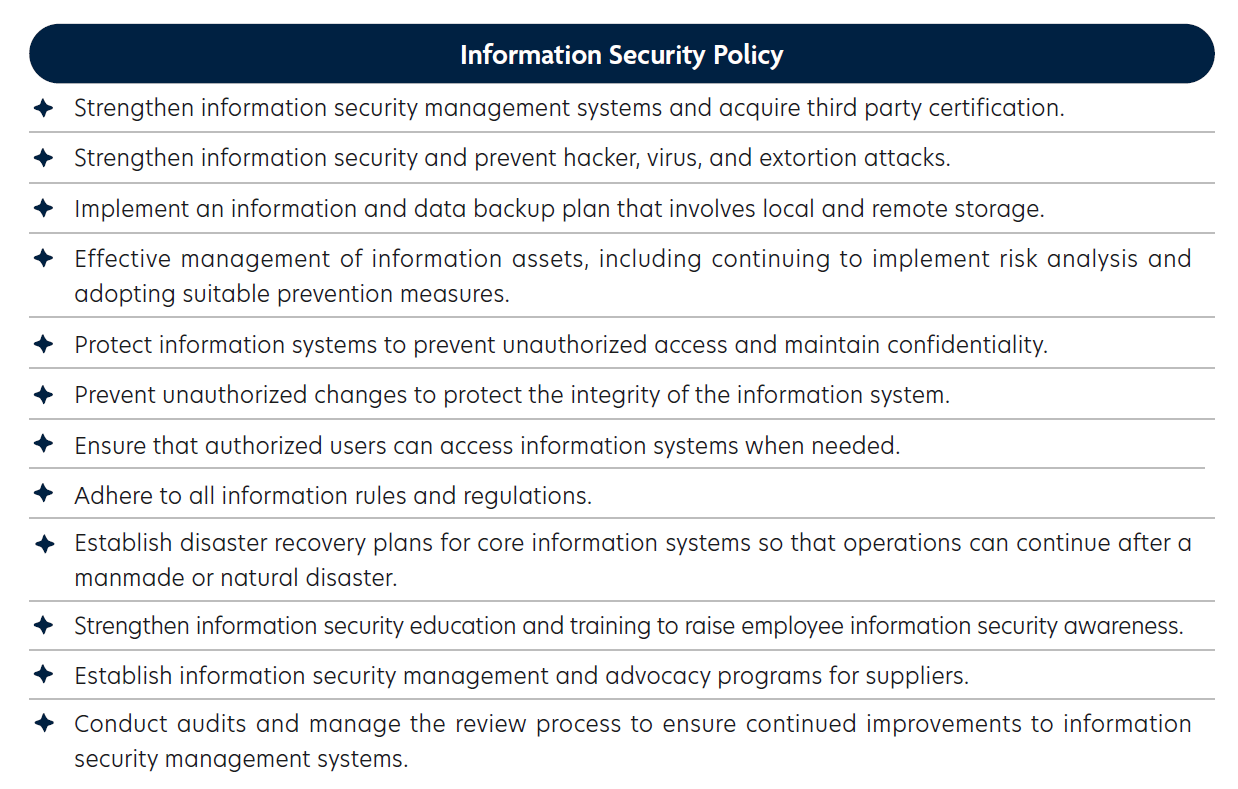
Information Security Management Methods
To evaluate whether information security management goals are met, ASPEED Technology adopted the following management methods:s

To support ISO27001 information security certification, the information security education and training for employees of ASPEED Technology were held twice a year in 2022 to strengthen information security awareness. The aim is for ASPEED Technology’s information security management to provide a more secure environment for employees, customers, suppliers, and cooperative partners.
The implementation and achievement of ASPEED Technology’s information security in 2022 are as follows:
- 23 Standards completed documentation for information security-related standards.
- 1 Time each year the Company holds at least one information security management review meeting.
- 2 Time each year the Company holds at least two information security education and training meetings.
- 100% all 120 employees completed 2 hours of information security education and training class.
- 25 a total of 25 employees of relevant divisions completed 2 hours of information security management system document-based class.
- 12 information security promotion at least one information security promotion per month.
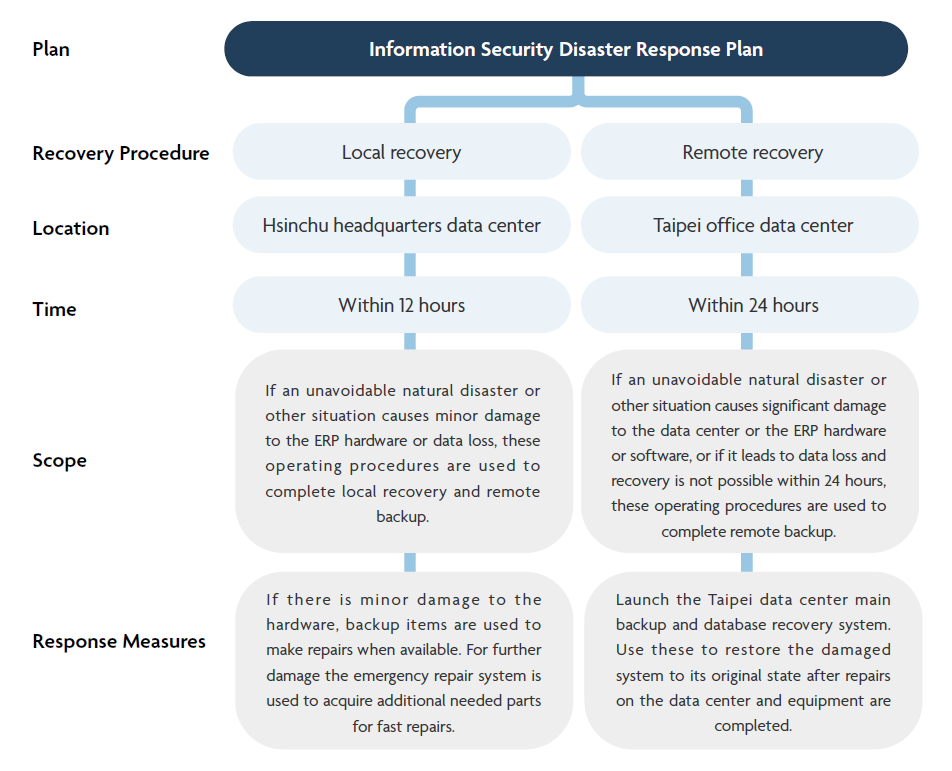
Ethical Corporate Management
Ethical corporate management is a core value of ASPEED Technology’s corporate governance and the highest principle of the Company’s conduct. The Company therefore formulated the “Corporate Code of Ethics” and the “Procedures for Ethical Management and Guidelines for Conduct.” It includes adherence to ethical corporate management policies as a condition of hire for new employees. When fulfilling work duties, all employees must act honestly and fairly while adhering to government laws and regulations. Board members and senior-level managers must also uphold ethical principles when running the Company. If the Company discovers that a business counterparty, supplier, or other partner conducts business in an unethical manner, we shall immediately terminate the business relationship and abstain from future business relations. These measures ensure effective implementation of our ethical corporate management policy.
The Sustainability Committee’s Corporate Governance Group and the Administration Division are responsible for advocacy and implementation of ASPEED Technology’s ethical corporate management. They formulate, explain, and consult on the procedures for ethical management and guidelines for conduct, while carrying out related procedures and oversight, including reporting and registration procedures as well as making periodic reports by the Sustainability Committee to the Board of Directors. The division holds regular and ad hoc educational training courses with employees to promote ethical corporate management, so the employees clearly understand related concepts and standards. The division also makes announcements to employees and discusses ways to strengthen ethical corporate management with managers. Employees must fully grasp the importance of ethical corporate management and practice it in their everyday work. When joining the Company, 100% of new employees must sign a guaranteed letter stating that they will adhere to the Articles of Incorporation and ethical corporate management principles. Moreover, they pledge to not violate or infringe intellectual property rights. If unethical behavior is found, administrative managers and managers from related departments review the incident, make improvements, and report to the Board of Directors. ASPEED Technology has always upheld fairness and justice, which is why we are firmly committed to fair business practices. We are firmly opposed to anti-competitive practices and support anti-trust and anti-monopoly practices. If any inappropriate behavior relating to ethical corporate management, anti-competitive practices, or anti-trust and anti-monopoly practices is discovered, employees and external stakeholders can directly report their findings to info@aspeedtech.com. In 2022, ASPEED Technology scrupulously abided by laws and social norms. No employees were involved in any work-related bribery or legal troubles, and none faced any work-related fines or penalties in Taiwan or overseas. ASPEED Technology recognizes the importance of moral business practices and internal ethical control mechanisms. In 2022, the Company began to plan an anonymous whistleblower system that is overseen by the Company’s internal Legal Management Division and audit units. We adopt an impartial and independent third-party reporting system, overseen by independent directors, to prevent internal corruption or unethical behaviors. The system is expected to go live in the second quarter of 2023, enabling ASPEED Technology to move towards a more complete and transparent governance operation.
Intellectual Property Rights Protection and Preservation
In the face of the global development of enterprise operations, the protection of intellectual property rights can be regarded as an important part of the global economic and trade layout and is the key to the sustainable development of enterprises. Innovation and R&D are the most important asset and mission of ASPEED Technology. We attach great importance to the acquisition and protection of intellectual property rights and patents of key technologies. In terms of patent distribution, we will continue to increase the quality and quantity of patents through the development of core technologies and high-quality products. Since its establishment in 2004, ASPEED Technology has devoted considerable efforts in obtaining and protecting patents and has encouraged its R&D team to actively obtain key patents. Following the establishment of a full-time Legal Management Division in 2021, in addition to evaluating the feasibility of patent applications and taking charge of domestic and foreign patent applications, we also embark on the planning of the intellectual property portfolio and the trade secret registration system, develop internal assessments and enhance bonus for patent applications, and actively encourage employees to innovate and develop. In 2022, we adhered to short-term and medium-to long-term development strategies, and make ASPEED Technology to adopt a more systematic approach to protect technological innovation and intellectual property rights, and continue to make efforts to build a long-term intelligent property rights layout. Looking ahead, ASPEED Technology will continue to improve the penetration and acquisition of SoC hardware and software R&D talents in the area of patents and intellectual properties, significantly enhancing the intellectual property layout of chips, thereby enhancing ASPEED Technology’s corporate value and international visibility.
Protection Strategies for Intellectual Property Rights
| Timeline | Strategy |
|---|---|
| Short-term development |
|
| Long-term development |
|

By 2022, ASPEED Technology had acquired 58 patents, consisting of 31 patents in Taiwan, 22 in the United States, and an additional five from Broadcom’s Emulex Pilot™ business. In 2022, the Company achieved its patent acquisition and application targets, including having acquired six four new Taiwan patents. The Company currently has 9 patent applications underway in Taiwan, 10 applications in the United States and 9 applications in China. Our patent applications cover a wide range of technologies found in core products, including seamless stitching and rotating of panoramic images as well as core technologies for image displays and tracking in wide-angle/panoramic image meeting systems.
| Key achievement | 2020 | 2021 | 2022 | 2022 achievements |
|---|---|---|---|---|
| Patent application | 5 | 24 | 27 |
|
| Patent acquisition | 3 | 4 | 9 |